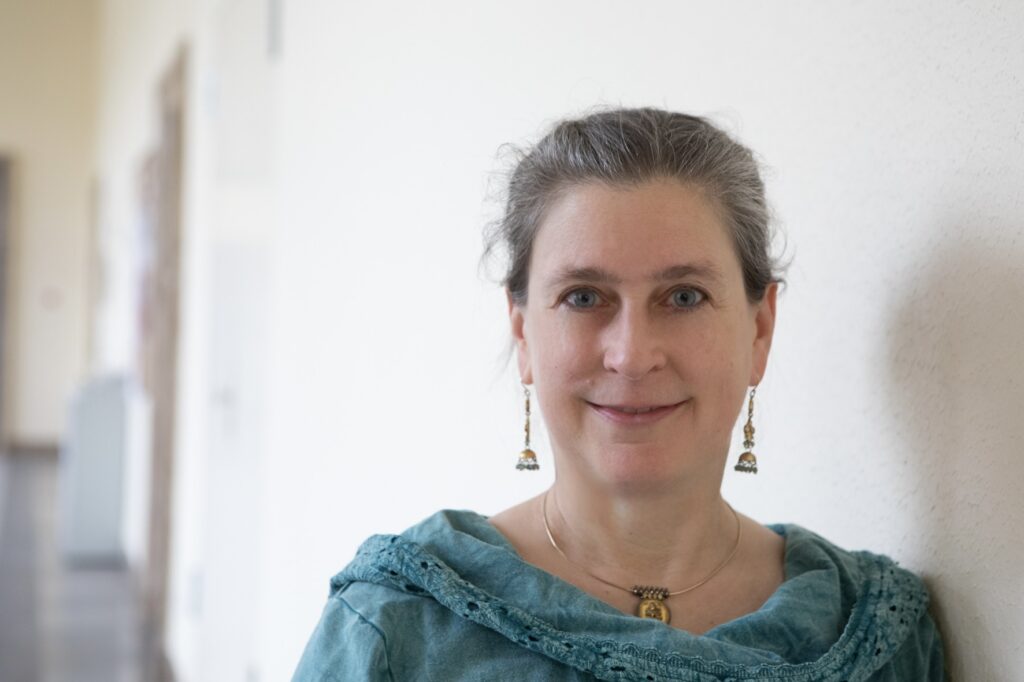
(hier klicken für deutsche Sprachversion)
Heike Oberlin (*1970), Executive Director of the Department of Indology at the University of Tübingen, has spent many years researching India’s performing arts and the Sanskrit theatre tradition of Kūṭiyāṭṭam. In this interview, the professor reflects on the transformation of Indology into a critically dialogical cultural science, her personal experiences with language and theatre in Kerala, and the responsibility of learning from the discipline’s history. A multiple award-winning scholar, Oberlin sees Indology as a bridge between India and Germany, rooted in philological depth but enriched by personal encounter and digital innovation. Her message to the next generation: „Have the courage to be curious, patience in learning, and openness“.
Professor Oberlin, when you look at the long history of Indology in Germany – from Rabindranath Tagore’s visit through the post-war era to today – what comes to mind when you connect this trajectory to your own path?
German Indology has evolved remarkably. It began with the romantic, idealised approaches of the 18th and 19th centuries – also evident in the strong resonance to Tagore – then moved towards philological rigour and institutional consolidation in the 20th century. From the 1970s onwards, it embraced cultural, social and performance-oriented perspectives. This breadth is unique to the field and allows us to ground ourselves in philology while at the same time engaging with continuity, rupture, and contemporary debates – including those in politics.
My own journey mirrors this arc. I was first drawn in by a “new yet ancient” world of thought revealed to me through Bharatanāṭyam. During my studies I discovered Kūṭiyāṭṭam and, through intense language study in Tübingen and several years in Kerala, immersed myself in both the theory and practice of this ancient theatre. What struck me most was that understanding is never static – a formative experience. Philological precision has remained my foundation, but the real essence lies in constantly reflecting on my role in the interplay of scholarship, art and human encounter. Today I pass this on to my doctoral students from India. Together, we work on text, practice and theory – knowledge-making understood as a cooperative, situated and critical practice. To me, Indology is less a guardian of a canon than a dialogical mediator between tradition and the present.
The history of the field shows that some Indologists after the Second World War had been closely tied to the Nazi regime (Lutz, Alsdorf, Heine, Wüst, Waldschmidt, Frauwallner). How does Indology in Germany today grapple with this legacy, while still building a positive bridge with India?
It is part of the discipline’s honesty to face its shadows. Some scholars failed to confront their complicity after 1945 and in some cases even continued to shape institutions. Today this entanglement is critically researched and openly addressed – also in teaching. Out of this has grown a new self-understanding: Indology is no longer the guardian of a supposedly “pure” canon but a reflective, philologically grounded cultural science. For me this means accepting responsibility for the past while also building bridges to the present – through my work in Kerala or in dialogue with my doctoral students from India. From this critical engagement, a foundation emerges that makes genuine encounters on equal footing possible.
You often describe Indology as a way of fostering intercultural understanding. When did you feel most clearly that your work was bringing people from India and Germany closer together?
Most vividly in my work with my PhD students from India. I once studied and lived in Kerala; they now come to Tübingen. What binds us is academic and artistic work, but also the shared experience of immersing oneself deeply in another language and culture – and being transformed in the process.
Intercultural understanding has also been lived very concretely through my more than thirty years of involvement with the German-Indian Cultural Society in Tübingen: countless concerts, dance performances, workshops and readings where people from both cultures have met one another with curiosity and respect.
Learning Malayalam is no small feat. Did you ever doubt yourself along the way? And what kept you going? What does the language mean to you today, both personally and professionally?
There were many moments of doubt: the Dravidian morphology, the wide range of sociolects and dialects alongside the literary standard language. What truly helped me was the immersion – living for two uninterrupted years in rural Kerala. Patient teachers guided me, but equally decisive were the long Kūṭiyāṭṭam commentaries written in Malayalam. On stage, each word is translated into hand gestures, even down to signs for grammatical endings such as case or number.
Today Malayalam brings me a sense of closeness. It unlocks humour, nuances of politeness, the fine registers of everyday life. In some situations, I think in Malayalam, which lets me experience relationships with less mediation. Professionally, it is the key to the stage and the archive: I can listen to Vidūṣaka passages, rehearsal directions and debates in Kūṭiyāṭṭam directly, conduct interviews, read programme notes and local research, work in archives – and above all, build trust. Language here is not just a tool but a form of relationship work. It shifts one’s role from external observer to partner in dialogue. That is why the persistence was more than worth it.
You have not only studied the Sanskrit theatre Kūṭiyāṭṭam but also practised it on stage. How has this shaped you as a person – perhaps even beyond academia?
Performing Kūṭiyāṭṭam gave me experiences that go far beyond scholarly analysis. My teachers, with great patience, introduced me into an art form centuries old. I learned that knowledge does not grow from texts or theories alone, but through experience – in shared practice, rigorous training, even in the silence between exercises.
In this bodily and vocal training – in eye movements, gestures, the recitation of texts – lay a profound lesson in patience, attentiveness and humility. It is not I who stand at the centre, but the tradition, into which I was allowed to step briefly. This has shaped me personally as well: it taught me how scholarship, art and personal encounter are inseparably intertwined. I began to see myself not as a detached observer but as a dialogical participant who carries responsibility to pass on what has been entrusted to her with respect. My teachers thus became not only artistic role models but lasting guides for a research ethos that translates tradition with care and continues it in mutual respect.
Digital technologies are transforming the humanities. What inspires you about these changes, and where do you see new opportunities to keep Indian culture alive?
I am inspired by how digital tools open up access that was once unthinkable. Manuscripts, performances or archives can now be shared and studied worldwide, unbound from geography – for example, the Tübingen “Gundert Portal” (https://gundert-portal.de). For Indian culture this means that rare traditions like Kūṭiyāṭṭam can be documented, annotated and made accessible to broader audiences – without reducing them to mere museum pieces.
The key is balance. Digitality preserves and conveys, but it cannot replace the living experience of language, art and human encounter. Ideally, both complement each other – digital reach and local, embodied presence – forming a vibrant bridge between past and present, between East and West.
Looking ahead to the next 25 years: What do you hope for – for your discipline, for the Indo-German connection, and for the next generation of students?
I hope Indology will continue to thrive – not something to be taken for granted these days – and ideally even expand, so that knowledge of Indian languages and the subcontinent’s diverse society is preserved. Students should continue to learn how to build bridges between scholarship, art and culture. At the same time, the discipline must preserve its philological depth – that is its core craft.
I hope, too, for a lively dialogue between Germany and India, where traditions like Kūṭiyāṭṭam are not only researched but also experienced and passed on within their historical and socio-cultural contexts.
For the next generation, my wish is simple: courage to be curious, patience in learning, and the openness to understand scholarship, art and personal encounter as inseparably intertwined.
Thank you very much!








